2006 VOLKSWAGEN GOLF MK5 check engine
[x] Cancel search: check enginePage 294 of 444

Booklet 3.2 Tip s and Advice
vehicl e handles diff ere ntl y wh en towin g a
tr ai ler because of the additional weigh t and weight distribution. Safe ty, pe rform ance and econo m y will greatl y depend on how carefull y
yo u load your trailer and op erat e your rig.
Before you actually to w your trail er, p ractic e
turning. stopping and b ack ing up in an area away from traffic until learn the feel of your vehicle and trail er unit.
Backing
up i s diffi cult and requi res practi ce.
Stee rin g whil e backing up is gen erall y opposite of that when backin g your vehicl e with out a
trailer.
Keep
more distance between your vehicl e and the one in front of yo u. will need more room to stop.
To compensate for the trail er. you will need a
larger than normal turning radius.
When passing, remember that you cannot erate as fast as you normally would because of the added load. Make sure yo u have enough
room to pass. After passing. allow plenty of room for you r trailer before c hanging lanes again.
Avoid je rk y s tart s, sharp turn s or rapid lan e changes.
Parking
After parking. always block th e wheels of both ve hicl e and trail er. Do not park with a traile r on a slope. If it cannot be a voided, do so only after doing th e follo wing:
Apply fo ot brake .
Have someone place chocks under both hicl e and trail er whee ls .
With the c hock s in place, s lo w ly re lease brak es until wheel blo cks absorb the load.
Turn w heels to curb (ve hicl e facing downhill)
o r to the stre et (when facing uphill).
Appl y parkin g brak e firmly.
automatic transmi ssion in
If you move the selecto r leve r of the automatic tran smission to
position.
Restarting
When restarting after parkin g on a slop e, reverse
the proc edure:
S tart the engine.
S hift transmission into gear.
le a se the parking brake and slowly move away from the wheel block s.
Stop and hav e someone re trie ve the wheel
b lock s.
Note
Neve r to w trailer during the break-in period of your vehicl e.
If yo u tow a trailer , yo ur Volksw age n m ay quire more frequent maimenance due to the
ext ra load.
Always check local reg ulations regardi ng
trailer to w in g.
Applies to vehicles: with anti-theft a larm system and a traile r towing set
Linking your trailer to the vehicle's anti-theft alarm system
The anti-theft alarm syste m will be triggere d as soon as the ele ctrical connec tion
between the trailer
and
or qualified
wo rkshop, if you want to inte grat e your trai le r to th e ve hicle's anti-theft a larm
Connecting your trailer to the anti-theft alarm syste m
If yo u ve hicle was built to include both the th eft al arm system and a trailer towin g th en t he trail er towing package (if available) is
in tegrated into the anti-theft alarm sys te m . Thi s
18 Driving and protecting the environment
Page 314 of 444
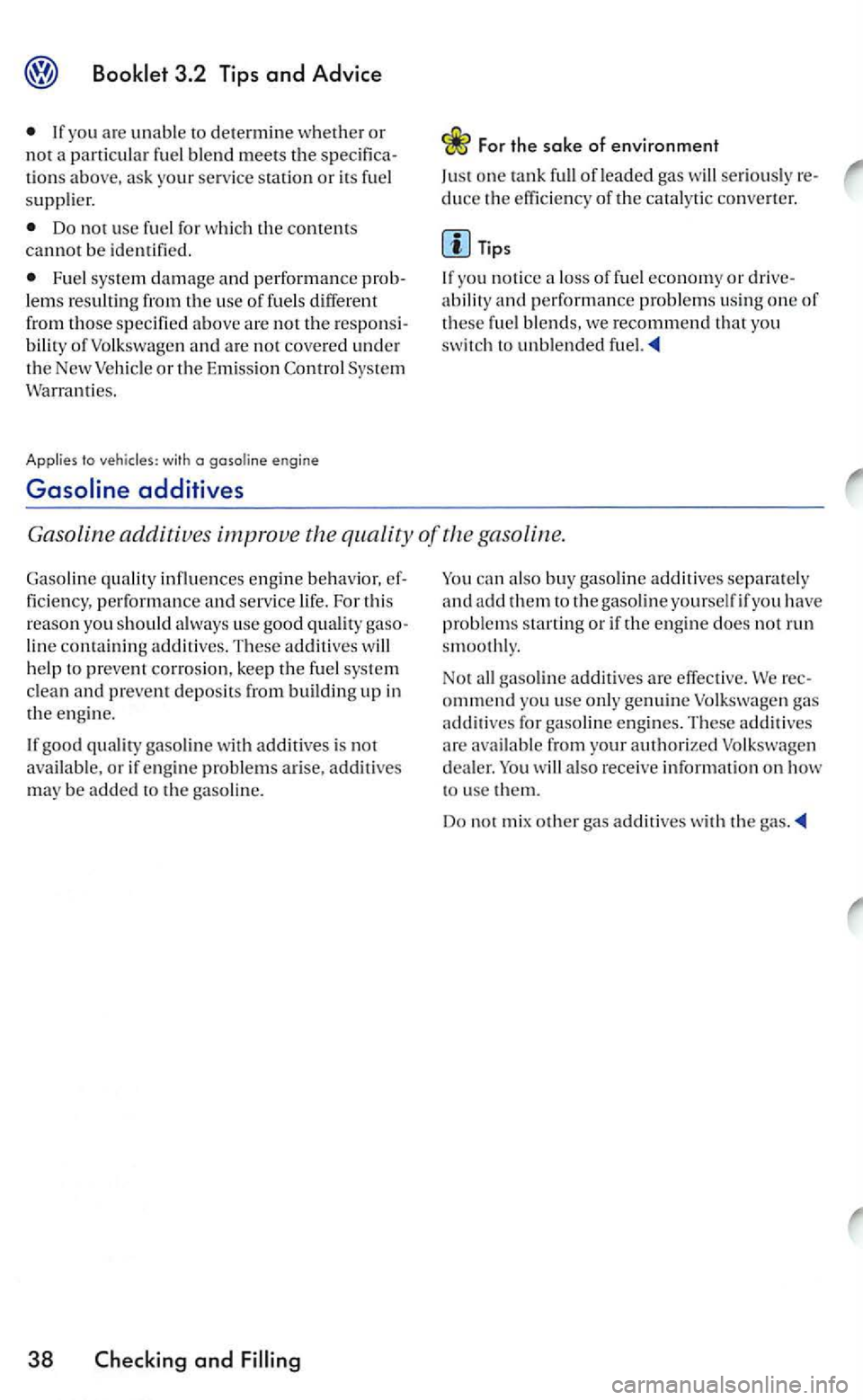
you are unable to determine whether or not a particular fuel blend meets the tions above, ask your service station or its fu el
s uppli er.
Do not use fuel for which the contents cannot be identifi ed.
F uel syste m damage and performance lems result ing from the use of fu els different
from those specified above are not the b ili ty of Volkswagen and are not covered under the New Vehicle or the Emi ssio n
Fo r the sake of environment
Just one tank f ull of leaded gas will seriou sly duce th e efficiency of the catalytic co nve rter.
you notice a lo ss of fuel economy or ability and performance problems using one of these fuel blends, we recommend th a t yo u
switc h to unblended
Gasoline additives improve the quality of the gasoline.
Gasolin e qualit y influences engine behavior, ficie ncy, performance and service life. For this
reason you should always use good quality line containin g additives. These additi ves will
h elp to prev ent corrosion, keep the fuel system clean and pre vent deposit s from building up in
the engine.
good quality gasolin e with additives is not availab le, or if eng in e probl em s arise, additives may be added to the gaso lin e.
38 Checking and
will also receive information on t o use them.
Do
Page 316 of 444
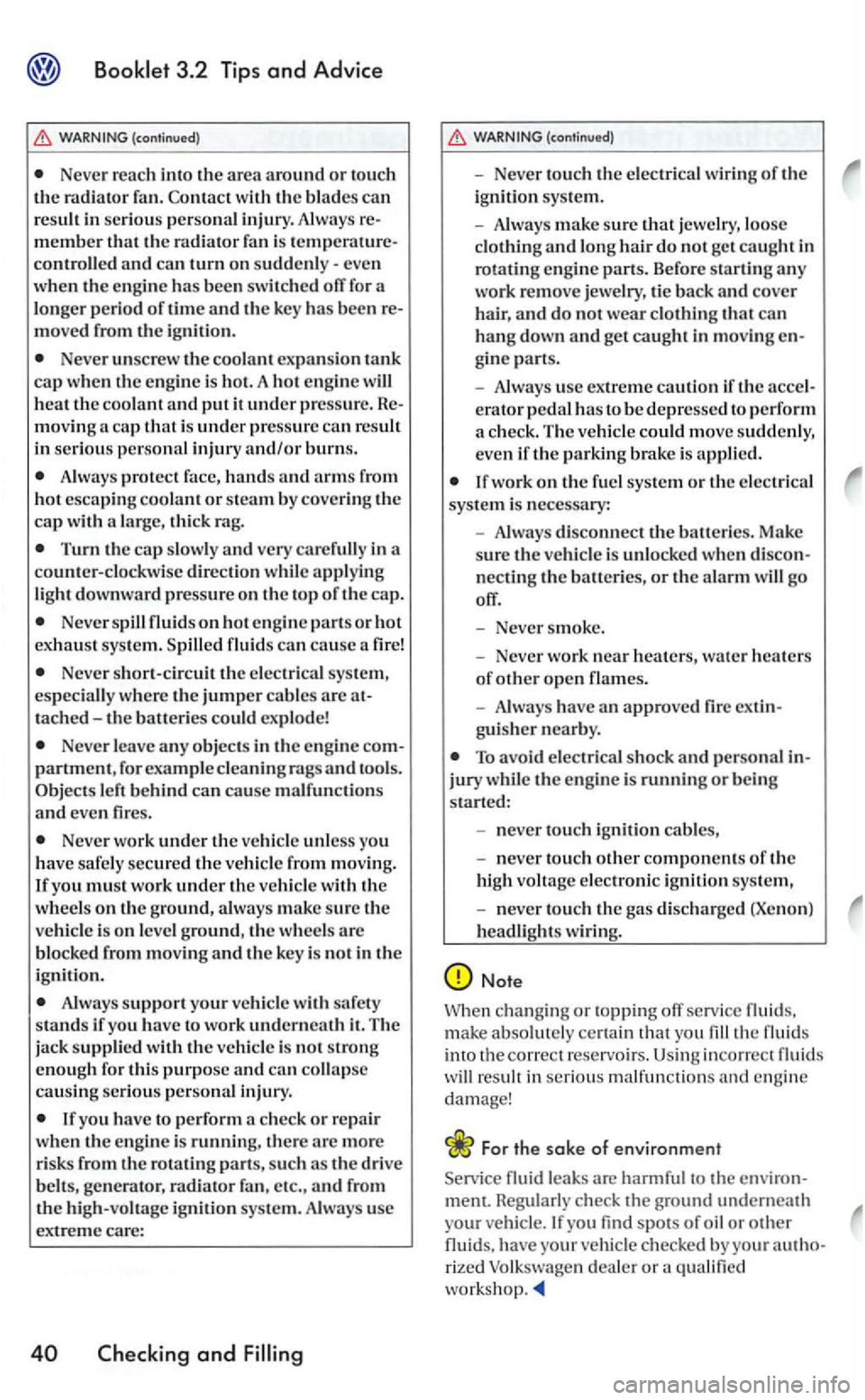
WARNING (continued)
Never reach into the area around or tou ch the radiator fan. Contact w ith the blade s can resuh in se riou s personal injury. Always m ember that the radiator fan is controll ed and can turn on
m oved from the ignit ion.
Never unscrew the coolant expa nsio n tank cap when th e engin e is hot. A hot engine will heat the coo la nt and put it under pressure . mov in g a cap that i s under pressure ca n rcsuh in seriou s personal injury and/or burns.
A lway s prote ct face, hand s and arms from hot esca ping coolant or steam b y cove ring the ca p with a large, thick rag.
Turn the cap slow ly a nd very carefully in a
counter- clo ckw ise direction whil e applying
light downward pressure on the top of the cap.
Never spill on hot engine parts o r hot
e xhau st sys te m . S pilled
Neve r short-circuitthc elec trica l sys te m ,
es peciall y w here th e jumper cabl es are tached -th e balleri es could explode!
Neve r leave any objects in the e ngine partment, for exam ple cleaning rag s and too ls. Objects
Neve r work unde r the veh ic le unless you
h ave safely secured th e ve hicl e from movin g.
I f yo u must work under th e ve hicl e wit h th e
w hee ls on th e ground, always make sure the vehicl e is on leve l ground, th e wh eels arc
b locked from movin g and th e key is not in the
ignition.
Always support your ve hicle with safety
s tands if you have to wo rk underneath it. The
ja ck suppli ed with the ve hicle is not s tron g enough for this purpose and can co llap se causin g se riou s personal injury.
If you have to perform a check or r ep a ir
w hen th e e ngine is running, there arc more
ri sks from
the ro tating parts, such as the drive
WARNING (con tinued)
Neve r to uch the e lec tr ica l w ir in g of the ig ni tio n sys tem.
Always make sure that j ewe lry, loose clothing and lo ng hair do not get caught in
rota ting engine pans. Before startin g any work remove jewelry, tie back and cover
hair, and do not wear clothing that can hang down and get caught in mov ing gin e parts.
Always use extre me cauti on if the erator pedal has to be depresse d to perform
a ch eck. The vehicle could move suddenly, eve n if the parking brake is applied.
If wor k on the fu el sys te m or th e electrica l
syste m is necessa ry:
Always discon nect th e balleries. Make
sure th e vehicle is unlo cked when
Neve r sm oke .
Neve r work nea r heaters, wa te r h eaters of other open names .
A lways have an approve d fire ext guis her nearby.
To avo id electrical shock and personal jury w hil e the eng ine is running or being
s tarted :
n ever touch ignition cables,
never to uch othe r component s of the
high vohage electronic ignition syste m,
never touch the gas discharged (Xeno n) headlights wiring.
Note
Whe n chang ing or topp ing orr service fluids. make absolutel y ce rtain that you fill the fluid s
into the corr ect reservoirs. Using incorrec t fluids will resuh in serious malf unct ions and engine
damage!
For the sake of environment
Service fluid leaks are harmful to the environ-
ment. Reg ularl y check the ground undernea th
your vehicle . you find spots of oil or other
fluids. have your vehic le checked by your rized dealer or a qualified
Page 319 of 444
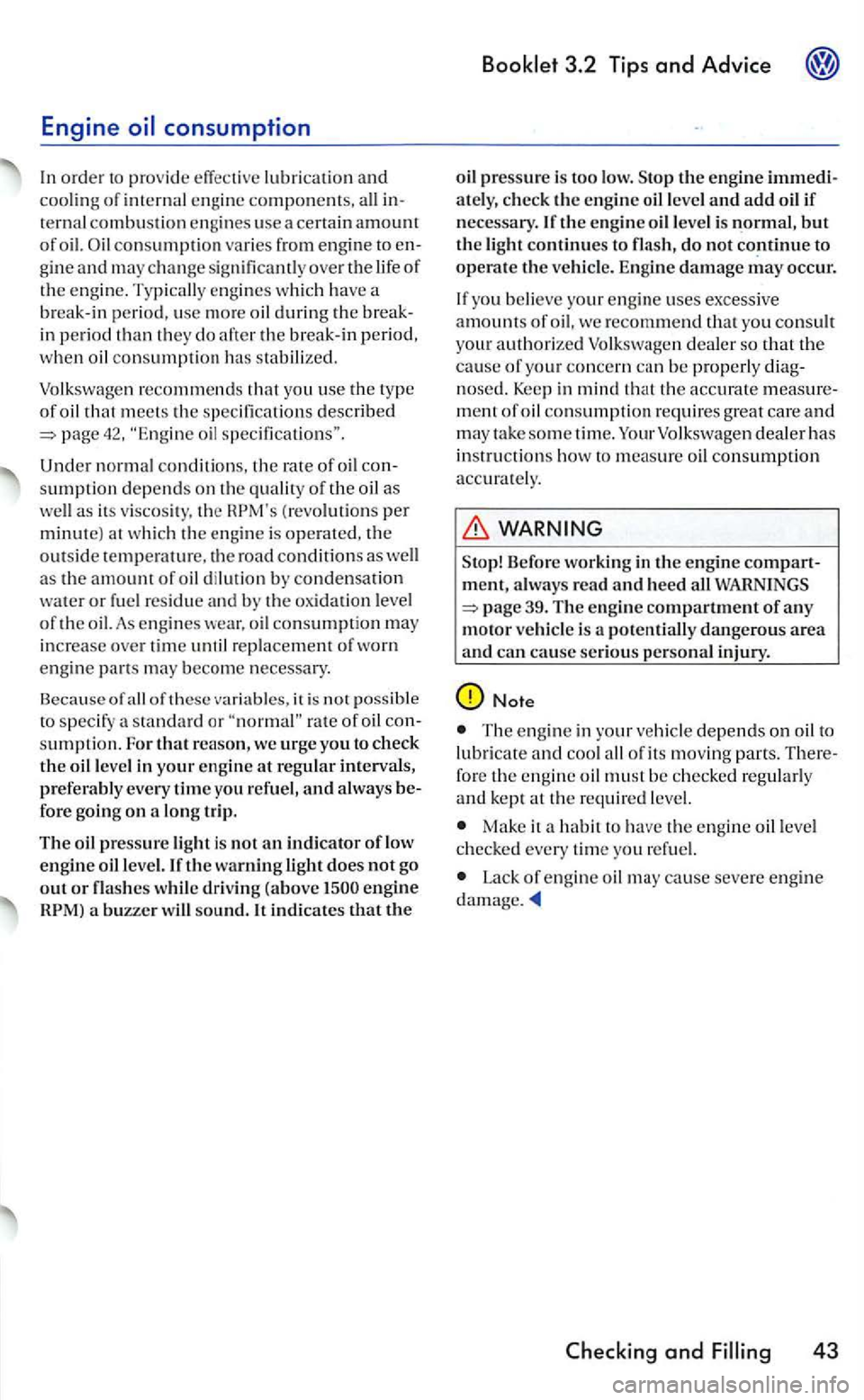
Engine
ternal combustion engines use a certain amount of oil.
th e break-in period,
when consumption has sta bili zed.
conditions, t he rate of
as its viscosity, th e
residue and by the oxidation level of the oil. As engines consumption may
increase over time
of thes e it is not rate of sumption. For reaso n, w e urge you to check the oil le vel in your engin e at regular interval s, prefe ra bl y every time yo u and always
fore go ing o n a trip.
The
en gine
pressure is too low. S to p the en gine ately, check th e en g in e o il leve l and add if
n ecessary . If th e e ng ine oil level is no rmal, but
th e light con tinues to flash, do not continue to
o pera te t he ve hicl e. Engine damage
so that th e cause of your concern can be pro perly
ment of consumpt ion requires great care and may take sometime. consumption
Sto p! Be fore workin g in the e ngine ment, always read an d heed all WARN INGS 39. The e ng in e compart m en t of any moto r ve hic le is a potentially dangero us a rea and can cause serious pe rsonal inju ry.
0Note
The eng ine in you r to all of it s movin g pa rts. fore th e en g in e must be ch ecked and kept at th e required
Make it a habit to have the engine
Lack of engine
and
Page 320 of 444
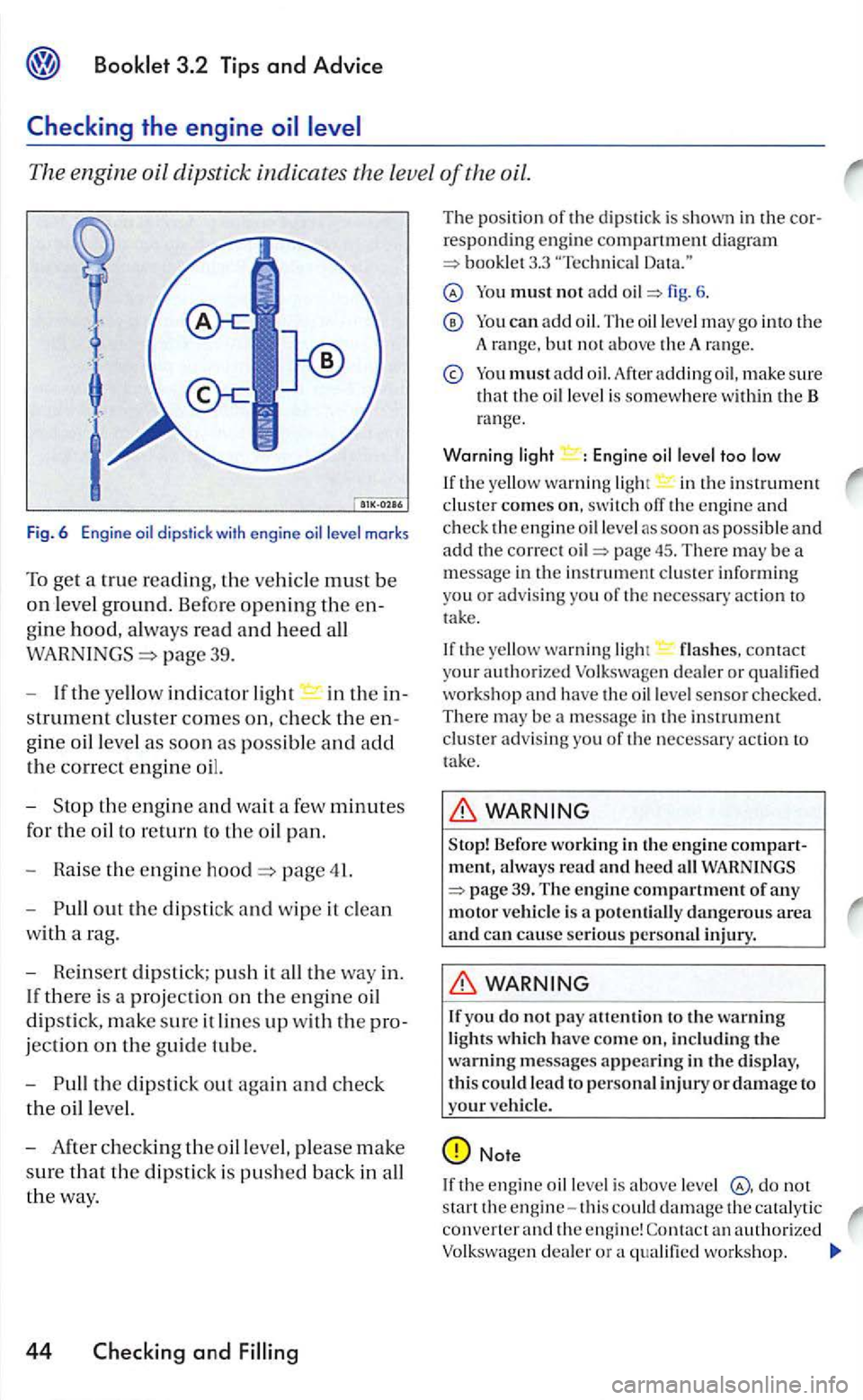
The engine oil dipstick indicates the leve l of the oil.
Fig. 6 E ngine level marks
To get a true reading, the ve hicl e must be
on leve l ground. Before opening the en
gine hood, always read and heed all
page 39.
If the yellow indicator light in th e in-
s
trument cluster comes on, check the e n
gine o
il leve l as soon as possible and add
the correct engin e oil.
the eng in e and wait a few minutes
for
the oil to return to the o il pan.
p a ge 41.
out the dipstic k and w ip e it clean
w ith a rag.
Rein se rt dips tick; push it all the way in.
If
ther e is a projection on the en gin e oi l
dipstick, make sure it lines up with the pro
jection on the guide tube.
the dipsti ck out aga in and ch eck
the o il l evel.
You must not add fig. 6 .
You can add
You m ust add oil. adding oil, make sure the level is somewhere within t h e B range.
Warning light : Engin e oi l level too low
If the yellow warn in g ligh t in the instrument cluster comes on, switc h ofT the engine and check the engine level as soon as possible and add the correct page 45. There may be a message in the instrumem cluste r informing you or advis ing you of the necessary action to
take.
If the yello w
warning ligh t flashes, contact your authorized Volkswa gen dealer or qualified workshop and have the oil leve l sensor checked. There be
WARN IN G
Before workin g in th e e ng in e compartm ent, always read and heed 39. T he engin e compartment of any motor vehicl e is potentiall y dangerous are a and can cause serio us personal injury.
WARN ING
If you do not pay attentio n to the warning light s which ha ve com e o n, incl ud in g the warning messages appearing in the d isplay, this could lead t o personal in juryordamage to
your ve hicle.
Note
If the engine oil is above level not
start the engine-this could damage the catal ytic converter and the engi ne!
Page 321 of 444
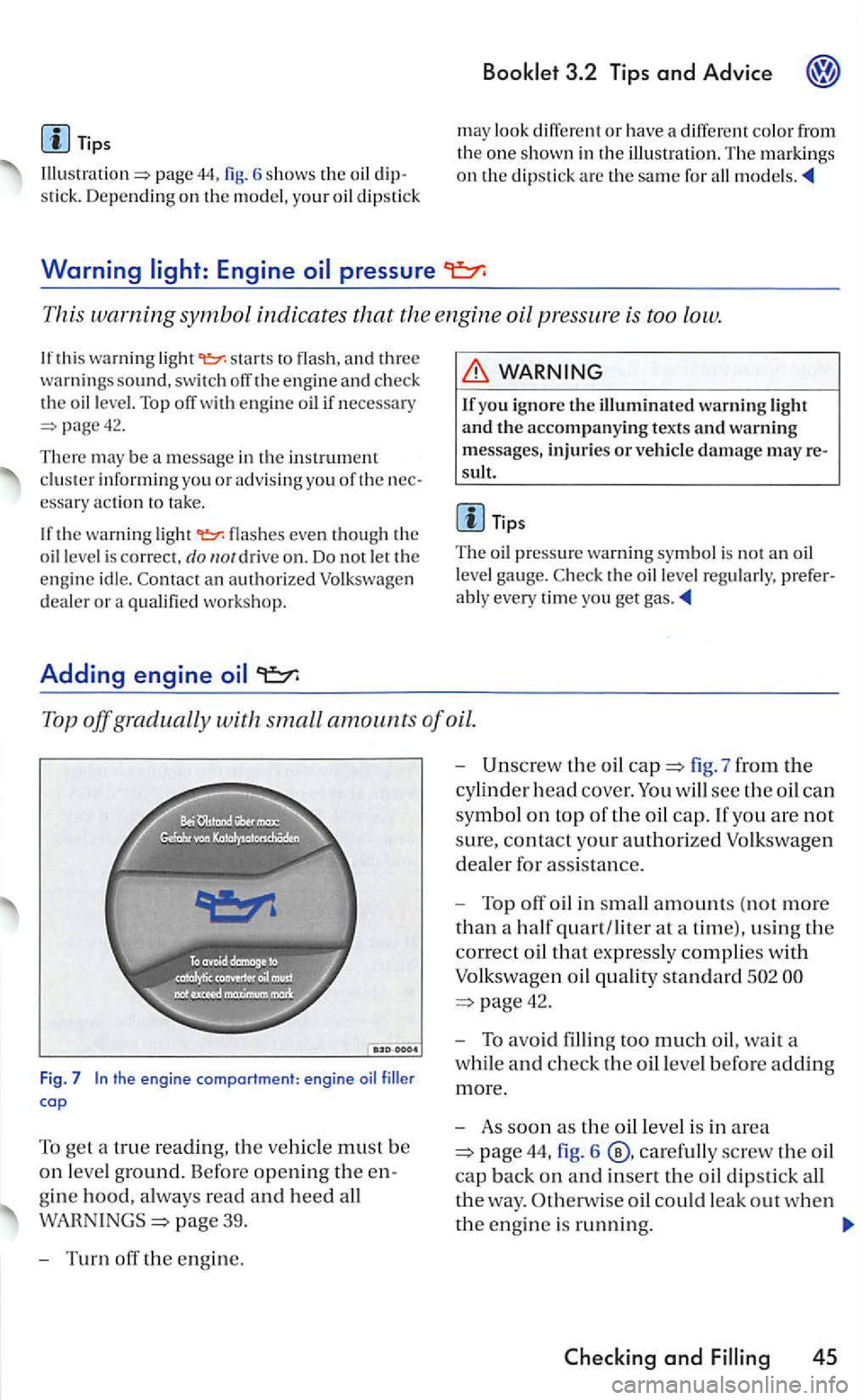
Tips
6 shows the oi l stick. Depending on the model, your dipstick
Booklet 3.2 Tips and Advice
may look different or have a different colo r from
t h e one shown in th e illustration. The markin gs on the dipstick are th e same for
Warning
This warning symbol indicates that the engine oil pressure is too low.
th is warning light start s to nash, and three warnings sound. switch off the engine and check the oil level. Top off with engine oil if necess ary
essary action to tak e.
If
the warning flas hes even the
oil le ve l is correct, do no/drive on. Do not ler the engine idle. Contact an authorized Volkswagen dealer or a qualified works hop.
Adding engine
WARNING
If yo u ignore the illum inated warning light and the accompanying texts and warning messages, injuries or vehicle damage may s ult.
Tips
The oil pressure warning symbol i s not an oil
level gauge. Check the oil leve l regu larly,
Top off gradually with small amounts of
Fig. 7
must b e
on leve l ground. Before opening the
WAHNINGS 39.
Turn off the e ngin e.
Un screw the oil fig. 7 from the
cy lind er head cover. see the can
symbol on to p of the oil cap. If you a re not
sure, con tact your authorized
off oil in amounts (not more
than a hal f quart/liter at a time). using the
correct oil that expressly complies with
quality standard
page42.
too much
As soon as the oil l evel is in area
d ipstick all
the way. Othetw ise oil could
and Filling 45
Page 322 of 444
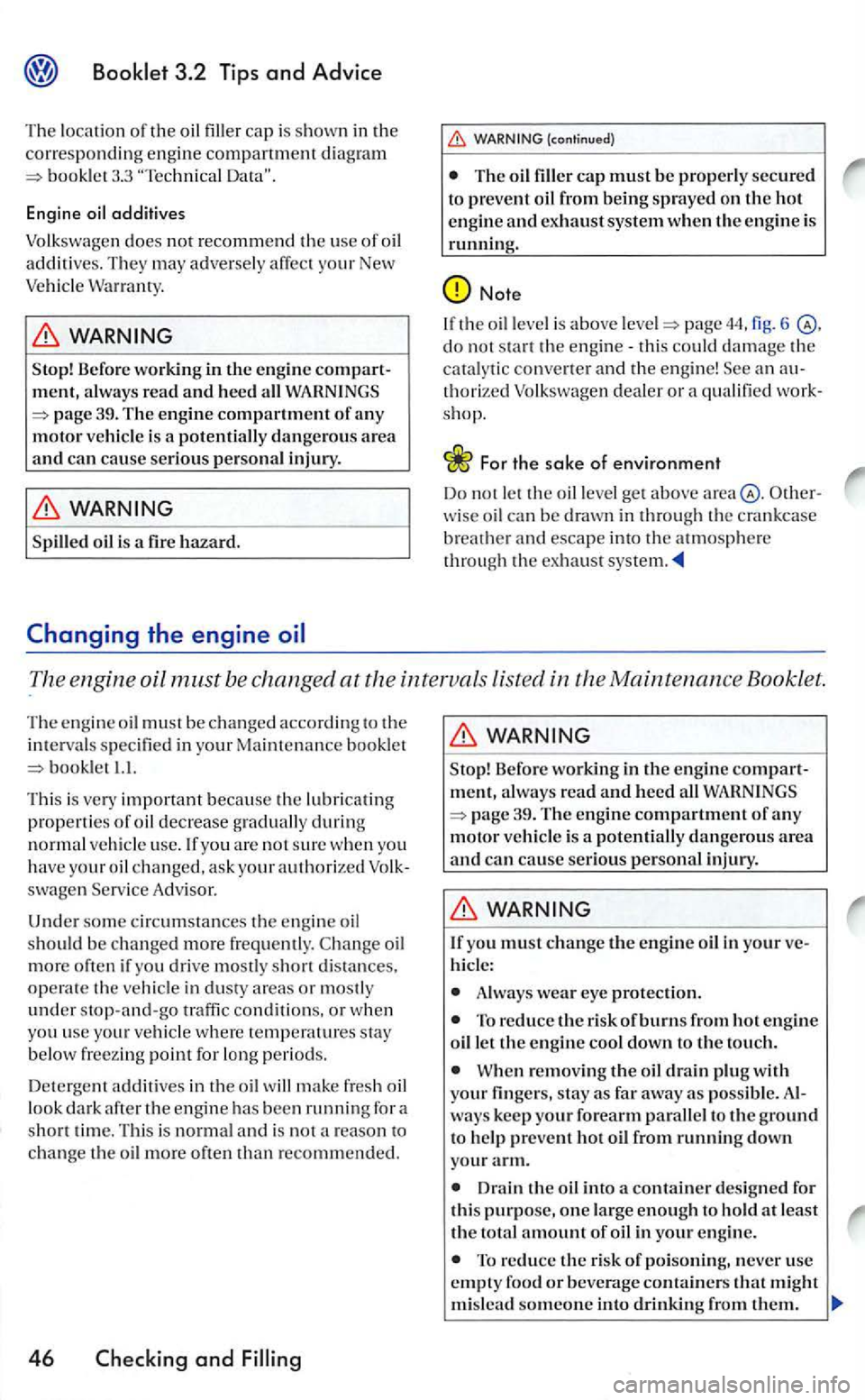
3.3
additives
Volkswagen
does not recommend the use of oil additives. They may adversel y affec t your New Vehicl e
Befor e worki ng in the engine compart
m ent, a lw ays read and heed all
Spilled oil is a fire hazard.
Changing the engine oil
(continued)
The oil filler cap must b e properly secured
to prevent oil from being sprayed o n the hot e ngine and exhaust system w hen the engin e is running.
th e oil is above pag e 44, fig. 6 do not start t he engine-thi s c ould damage the cata lytic convert er a nd the en g ine! a n au
t h orized Volkswage n dealer or a qualified work
s hop.
Fo r the sake of environment
Do not the oil leve l ge t above Other
wise oil can be drawn in throu gh the cra nkcase breather and escape in to the atmosp he re
throug h the exhaust system.
Th e engine oil must be changed at the interuals listed in the Maintenanc e Booklet .
The engine oil must b e changed according to the int erv a ls s pecified in your Maintenance booklet book le t 1.1.
Thi s is ve ry important beca use th e lubricatin g
prop ertie s of oil decreas e gra dually during
n ormal ve hicl e use . yo u arc not sure w hen you
hav e yo ur oil changed , ask your authorized Volkswagen Service A dvisor.
Und er
som e c irc um sta nc es the engin e oil
shoul d b e changed more frequently. more often if yo u drive mostly short distances. ope ra te the ve hicle in dusty area s or mostly under s top -and-go traffic conditi ons, or w hen
yo u use vehicle where stay
below fre e zin g point for long period s.
D eterg e
nt addit ive s in the oil will make fr es h oil
look dar k after the engine has been running for a short tim e. This is norm al and is not a reaso n to
c h a nge the oil more often than recommend ed .
46 Checking and
Before working in the engine compart
m ent, alway s read and heed a ll
yo u must chan ge the en gin e oil in your ve
hicl e:
Alwa ys wear eye protectio n.
To reduce the riskofburns from ho t engine
oil l e t the e ngine cool down to the to u ch.
W hen r emoving the oil dra in plu g with your fin gers, stay as far away as possibl e. Al
ways keep your forearm paralle l to the ground to help prevent hot oil from running down your arm.
Dra in the oil into a containe r designed for this purpose, one large enough to ho ld at least the tota l amount of oil in your engine.
To reduce the risk of poisoning, n e ver u se
empty food or beverage containe rs that might mis lead someon e into drinking from th em .
Page 324 of 444
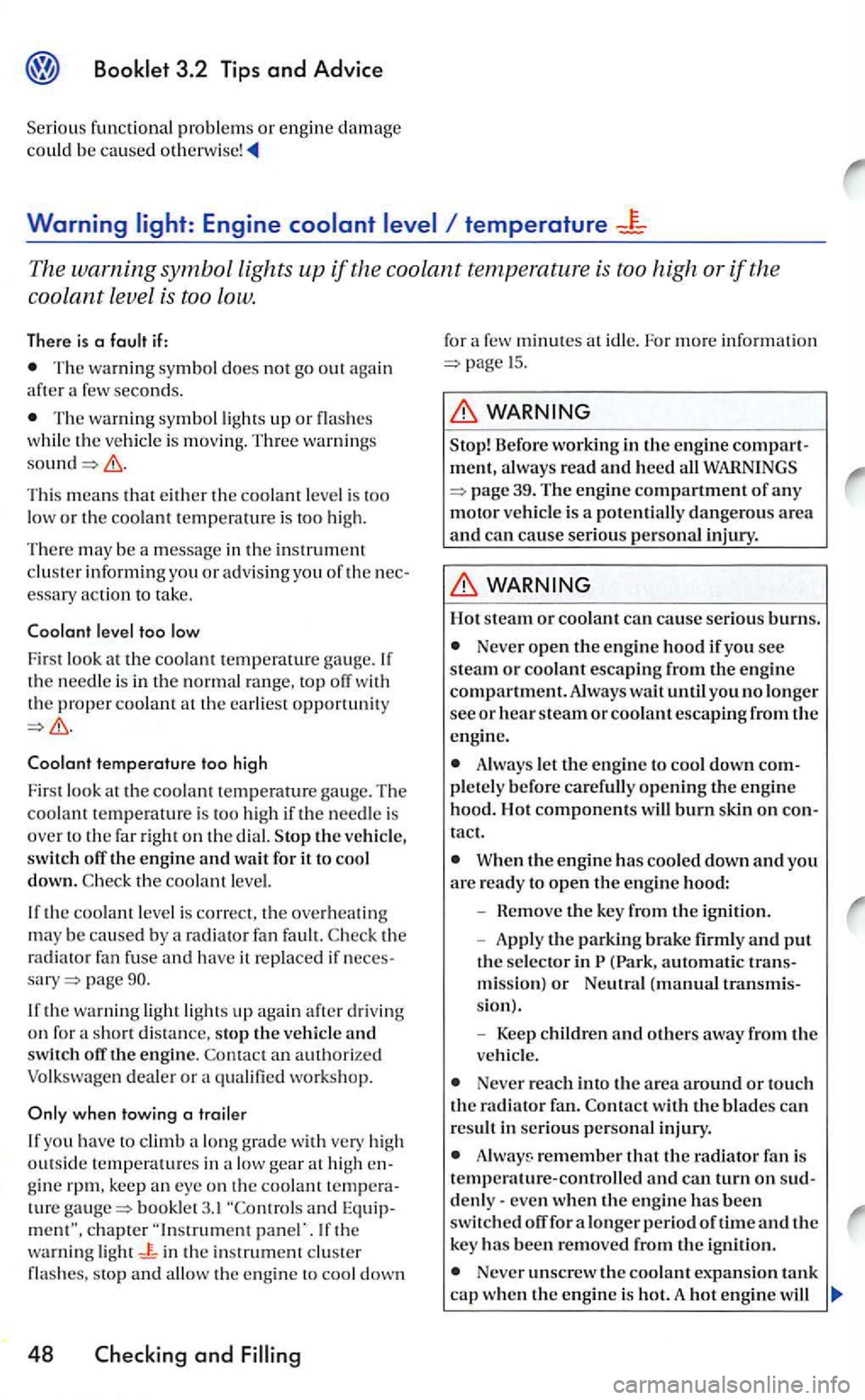
Booklet 3.2 Tips and Advice
functional problem s or engine damage could be caused
Warning temperature
The warning symbol lights up if the coolant temperatur e is too high or if the
coolant level is too
Low.
Ther e is a fault if:
The wa rnin g symbol does not go out aga in afte r a few seconds.
The wa rnin g symbol light s up or flas hes whil e the vehicle is moving. Three warning s
This means th at eith er th e coolant leve l is too low or the coo lant temperature is too high.
Th ere may be a m essage in the i
nstrument
clu ste r inf orming you or advi sing you of th e
Coolant temperature too high
Fir st look at the coolan t tempe rature gau ge. The coolant temperature is too hi gh if th e need le is
o ver to th e fa r right on the dial. the vehicle,
switc h the engine wait for it to cool down. the coo lant level.
I f th e coo lant level is co rrect, th e over heating may be caused by a radia tor fan fault. the ra diator fan fuse and have it replaced if page
If th e wa rnin g light lights up again after driving
o n for short distan ce, stop the vehicle switch otT th e e ngine. an authorized Volkswagen dea le r or a qu alified worksh op.
when towing a trailer
If you have to c limb a lo ng g rad e w ith high temperatures in low gea r at high gin e ture booklet 3. 1 and If th e
w arning light in th e in st rument cluster flas hes, stop and a llo w the e ngine to coo l down
48 Checking and Filling
for minutes at idl e. For more inform ation 15.
alw ays read and heed all
Hot steam or coolant ca n cause seriou s burns.
Neve r open the engine hood if you see steam or coolant escaping from the engine compartment. Always wait until you no longe r see or hear steam or coolant escaping from the
e n gine.
Always let the engine to cool down pl ete ly before carefully opening the engin e hood. Hot components will burn tact.
When the engine has coo led down and you are ready to open the engine hood:
-
move the key f rom the ignitio n.
- Appl y
the parking brake firmly and put the selector in ( Park, automatic mission) or Neutral (manual
Never reach into the area around or tou ch
th e rad iator fan. with the blades ca n
re sult in serio us personal injury.
remembe r th at the radiator fan is temperature-controlled and can turn on
fo r a longer p eriod of tim e and the
key has been r emoved fro m the ig nition.
Never unscrew the coola nt expansion tank cap when the e ngin e is hot. A hot engine will